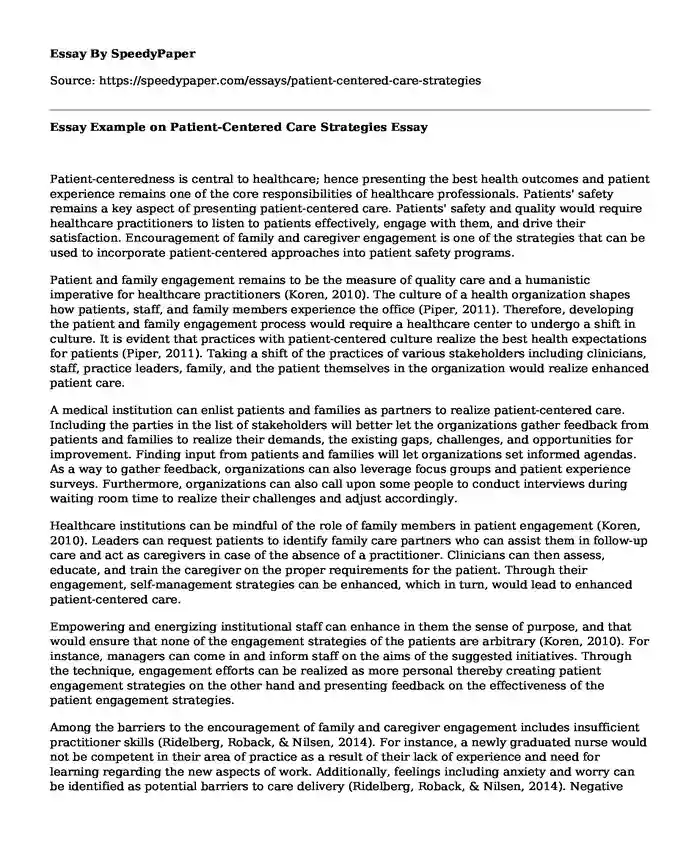
| Type of paper: | Essay |
| Categories: | Medicine Healthcare Healthcare policy Nursing care |
| Pages: | 3 |
| Wordcount: | 700 words |
Patient-centeredness is central to healthcare; hence presenting the best health outcomes and patient experience remains one of the core responsibilities of healthcare professionals. Patients' safety remains a key aspect of presenting patient-centered care. Patients' safety and quality would require healthcare practitioners to listen to patients effectively, engage with them, and drive their satisfaction. Encouragement of family and caregiver engagement is one of the strategies that can be used to incorporate patient-centered approaches into patient safety programs.
Patient and family engagement remains to be the measure of quality care and a humanistic imperative for healthcare practitioners (Koren, 2010). The culture of a health organization shapes how patients, staff, and family members experience the office (Piper, 2011). Therefore, developing the patient and family engagement process would require a healthcare center to undergo a shift in culture. It is evident that practices with patient-centered culture realize the best health expectations for patients (Piper, 2011). Taking a shift of the practices of various stakeholders including clinicians, staff, practice leaders, family, and the patient themselves in the organization would realize enhanced patient care.
A medical institution can enlist patients and families as partners to realize patient-centered care. Including the parties in the list of stakeholders will better let the organizations gather feedback from patients and families to realize their demands, the existing gaps, challenges, and opportunities for improvement. Finding input from patients and families will let organizations set informed agendas. As a way to gather feedback, organizations can also leverage focus groups and patient experience surveys. Furthermore, organizations can also call upon some people to conduct interviews during waiting room time to realize their challenges and adjust accordingly.
Healthcare institutions can be mindful of the role of family members in patient engagement (Koren, 2010). Leaders can request patients to identify family care partners who can assist them in follow-up care and act as caregivers in case of the absence of a practitioner. Clinicians can then assess, educate, and train the caregiver on the proper requirements for the patient. Through their engagement, self-management strategies can be enhanced, which in turn, would lead to enhanced patient-centered care.
Empowering and energizing institutional staff can enhance in them the sense of purpose, and that would ensure that none of the engagement strategies of the patients are arbitrary (Koren, 2010). For instance, managers can come in and inform staff on the aims of the suggested initiatives. Through the technique, engagement efforts can be realized as more personal thereby creating patient engagement strategies on the other hand and presenting feedback on the effectiveness of the patient engagement strategies.
Among the barriers to the encouragement of family and caregiver engagement includes insufficient practitioner skills (Ridelberg, Roback, & Nilsen, 2014). For instance, a newly graduated nurse would not be competent in their area of practice as a result of their lack of experience and need for learning regarding the new aspects of work. Additionally, feelings including anxiety and worry can be identified as potential barriers to care delivery (Ridelberg, Roback, & Nilsen, 2014). Negative feelings could enhance reluctance at the workplace, especially in the admitting to faults and the reporting of challenges. Lack of collaboration between physicians and other healthcare professionals is a hindrance to patient-centered care (Ridelberg, Roback, & Nilsen, 2014). Poor communication techniques are also a challenge to patient-centered care as nurses may be unwilling to share knowledge (Gong, Song, Wu, & Hua, 2015).
Emphasizing patient and family engagement in pre-existing initiatives should be the way to improved patient-centered care. Through the strategy, staff, clinical leaders, patients, and family members are considered during culture shifts, which enhance quality care delivery. A shift in culture is, therefore, ultimately one of the best ways to ensure that treatment makes sense to the individual patient.
References
Gong, Y., Song, H. Y., Wu, X., & Hua, L. (2015). Identifying barriers and benefits of patient safety event reporting toward user-centered design. Safety in Health, 1(1), 7.
Koren, M. J. (2010). Person-centered care for nursing home residents: The culture-change movement. Health Affairs, 29(2), 312-317.
Piper, L. E. (2011). The ethical leadership challenge: creating a culture of patient-and-family-centered care in the hospital setting. The health care manager, 30(2), 125-132.
Ridelberg, M., Roback, K., & Nilsen, P. (2014). Facilitators and barriers influencing patient safety in Swedish hospitals: a qualitative study of nurses' perceptions. BMC Nursing, 13(1), 1.
Cite this page
Essay Example on Patient-Centered Care Strategies. (2022, Nov 21). Retrieved from https://speedypaper.com/essays/patient-centered-care-strategies
Request Removal
If you are the original author of this essay and no longer wish to have it published on the SpeedyPaper website, please click below to request its removal:
- What Is Behavior - Nature Or Nurture? Essay Samples
- Free Essay: The Wharton Rule and Criminal Cases That Involve a Conspiracy
- Free Essay on Entrepreneurship Business Plan - Technological Restaurant
- Essay Sample about Leadership
- Essay Sample about Nike's Hypocrisy in Supporting Colin Kaepernick's
- Essay Example on Impact of Technology and Social Media on People
- Essay Sample on How Macbeth Reacts to Success
Popular categories




